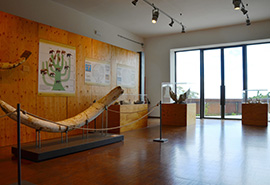The museum which opened in 2001 and was renewed in 2007, together with the restoration of the entire Ducal Castle that houses it.
It is a museum focused on the prehistory of the valley of the Aventine in Palena, in the area called "Capo di Fiume". It has been established as a lithostratigraphic success containing levels dating back to the late Miocene period, containing rich continental fossil and lagoon ambients.
The museum finds continuity at its natural origins, at the geological site of "Capo di Fiume" located at the source of the river Aventine. The founding core of the museum, that is, "The collection of Di Carlo," put together by Erminio Di Carlo comes from this area. In his long years of research and investigation in the area, of fish, molluscs, crustaceans, bird feathers and the whole skeleton of a Prolagus perfectly preserved.
The museum route is divided into five rooms: Hall of knowledge, Palena the lagoon, Palena the mainland, The Aventine hall and The large mammals of the Quaternary. All supported by the presence of a teaching aid room aimed at younger visitors to the museum called "Geologiocando".

The museum which opened in 2001 and was renewed in 2007, together with the restoration of the entire Ducal Castle that houses it.
It is a museum focused on the prehistory of the valley of the Aventine in Palena, in the area called "Capo di Fiume". It has been established as a lithostratigraphic success containing levels dating back to the late Miocene period, containing rich continental fossil and lagoon ambients.
The museum finds continuity at its natural origins, at the geological site of "Capo di Fiume" located at the source of the river Aventine. The founding core of the museum, that is, "The collection of Di Carlo," put together by Erminio Di Carlo comes from this area. In his long years of research and investigation in the area, of fish, molluscs, crustaceans, bird feathers and the whole skeleton of a Prolagus perfectly preserved.
The museum route is divided into five rooms: Hall of knowledge, Palena the lagoon, Palena the mainland, The Aventine hall and The large mammals of the Quaternary. All supported by the presence of a teaching aid room aimed at younger visitors to the museum called "Geologiocando".



















